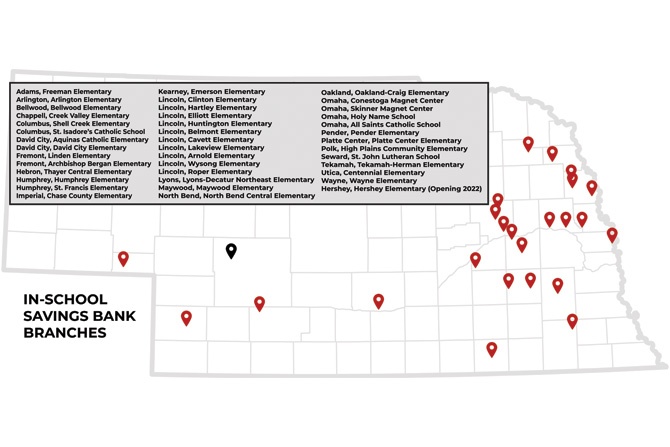Since arriving at the NBA in 2014, I have worked closely with the NBA Board of Directors and member banks to encourage and promote financial literacy. One fun, proven financial education strategy embraced by a growing number of NBA members is the creation and operation of in-school savings banks.
Nebraska’s first in-school savings bank opened in 2002 at the Conestoga Magnet School in Omaha. Today, 19 NBA member banks operate 34 in-school bank branches. At the beginning of this year, Nebraska banks and credit unions operated 36 in-school savings banks. The NBA’s internal goal is for members to commit to 22 new in-school bank branches in 2022.
In-school savings banks are deposit-only bank branches located inside elementary schools. They offer a fun, real-world experience and help students establish and reinforce a savings habit. Banks, local schools, the Nebraska Council on Economic Education and the Nebraska Department of Banking and Finance are partners in creating the in-school savings banks.
The branch is open one day a week to accept student deposits. Student tellers, trained by the partnering financial institution, staff the branch alongside a representative from the bank. In lieu of earning interest on their deposits, students receive incentive prizes. Free shirts, pencils and other promotional materials branded with the school bank and school logo, for instance, are greatly coveted. The school has a non-interest-bearing custodial account with the partner financial institution to serve as the main account for all student deposits. Students receive their savings balance, in the form of a check, when they move or graduate from the school.
The in-school bank branches not only educate students and increase their savings rates but also build positive relationships with their local bank. They also help to increase parental understanding and involvement in the financial system. The in-school branches have proven especially invaluable in higher-poverty schools.
As a result of the COVID-19 pandemic, the importance of financial education has become increasingly clear. Currently, more than one-half of Americans cannot afford a $400 emergency expense. Similarly, one-third of Americans report having little to no savings for retirement. In addition, a growing student loan debt crisis is financially suffocating the next generation, resulting in less purchasing, investment and savings power for Millennials and Generation Z.
Research conducted by Jennifer Davidson, president of the Nebraska Council on Economic Education and an assistant professor at the University of Nebraska-Lincoln, found that students who participate in an in-school savings bank are much more likely to be banked as adults. In addition, student participants are also much more likely to be employed after high school. These students also make smarter choices about debt and student loans.
Davidson’s research also found that financial institutions partners’ primary motivation for participation was to provide an opportunity for students to improve their financial literacy and support the community they serve. The research also indicated that financial institution partners believed the program is well worth the cost.
An informal survey of NBA members who sponsor in-school savings banks also found high levels of satisfaction with the program. One NBA member described their in-school branches as one of the bank’s most cost-effective marketing, promotion, workforce recruitment and community reinvestment activity!
If you are interested in learning more about how your bank may benefit from an in-school savings bank, reach out to Kara Heideman (kara.heideman@nebankers.org) at the NBA or Dr. Jennifer Davidson at the Nebraska Council on Economic Education (jdavidson2@unl.edu).










